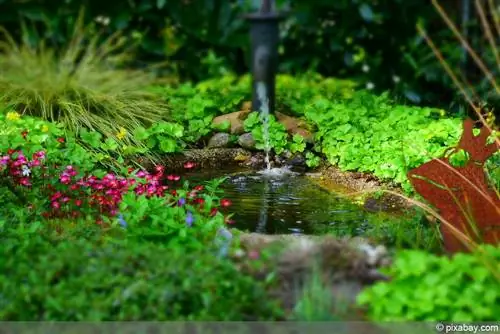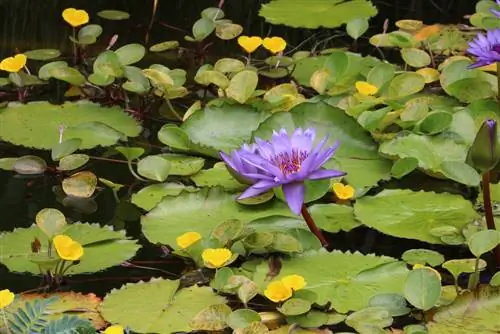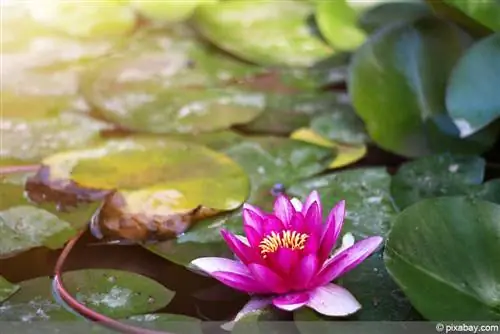- Author admin [email protected].
- Public 2023-12-17 03:39.
- Last modified 2025-01-24 12:45.
Every garden pond is a small biotope that functions according to its own rules. Plants play a central role in this. So it's no wonder that particular attention should be paid to planting a pond. Depending on the pond zone, it must be different, and not every plant is suitable for every zone. But with a little background knowledge you can easily get it under control.
Location
The location of a garden pond is not given by God. Rather, it is determined by the garden owner who plans to create a pond. The later planting should be taken into account as early as the planning phase. For a good reason: Practically all aquatic plants need a lot of light to grow and thrive. A location that is as sunny as possible is therefore an absolute must for every garden pond. In addition, there should be no deciduous trees in its immediate vicinity. On the one hand, these can affect the solar radiation on the pond. On the other hand, leaves falling into the pond in autumn can upset the biological balance.
Tip:
Leaves decompose in water to form sludge and thus endanger certain organisms. It therefore makes more than just sense to think about the plants when choosing a location for a pond.
Quantity
How many plants you can put on or in a garden pond obviously depends very much on the area. It should be borne in mind that aquatic plants often require a lot of space. The best example of this is the classic that no garden pond should be without, namely the water lily. Depending on the species, they can grow between one and four square meters - per plant, mind you. You shouldn't save on the size of the pond from the outset. However, this is often limited by certain factors in the garden. Therefore, the planting should always be tailored to the pond area. There are three proven rules for planting a garden pond:
- Under no circumstances plant the entire garden pond!
- Provide a maximum of two thirds of the area with flowering plants!
- If possible, avoid planting more than half of the pond!
If you keep these rules in mind when planting, you can't really go wrong with the quantity of plants. They serve as a guide, so to speak. You could also summarize these little rules like this: Less is more! It's not just about the look, although this of course plays a big role. A garden pond that is so heavily planted that you can hardly see any water surface is unlikely to fulfill its purpose. What is much more important is that too many plants in the pond can promote the growth of algae. Too many algae, in turn, endanger the biological balance in the generally very fragile ecosystem of a garden pond.
Pond zones

A garden pond is not just a hole in the ground into which water has been filled. Rather, it consists of different zones, each of which has its own purpose and the design of which is based on the conditions of natural bodies of water. Accordingly, a pond usually consists of a bank that initially merges gently into the water and finally leads to a deep area. When it comes to planting a pond, four zones can be distinguished:
- River Zone
- Shallow water with a water depth of up to 20 centimeters
- Deep water with a water depth between 30 and 60 centimeters
- Depth zone that lies about 1.5 meters below the water surface
The pond zones play a major role in planting. Basically, not every aquatic plant is suitable for every pond zone. In principle, the pond zones are for aquatic plants what the location is for conventional plants in general. A plant that absolutely needs a sunny location will hardly thrive in the shade. And an aquatic plant that needs a location in deep water usually dies very quickly on the bank. When choosing plants for your garden pond, you have to pay attention to which pond zone they are suitable for if you don't want to experience any unpleasant surprises.
Note:
Aquatic plants that are purchased from specialist retailers are generally provided with information about which pond zone they are suitable for. In most cases there is even precise information about the ideal water depth, which you should stick to.
Plants
The selection of plants with which you want to plant your garden pond depends on the respective pond zone. In the following small list, the plants are therefore arranged according to zones. This is only a small selection of possible plants. The key was to list typical aquatic plants on the one hand, but on the other hand to only mention those that can be obtained relatively easily.
River Zone
Understanding and very easy-care grasses are particularly suitable for the bank zone. The purpose of the bank planting is to frame the pond and thereby create visual accents. The plants also fulfill something like a filter function for the water. The most commonly planted plants are bamboo (Bambusoideae), miscanthus (Miscanthus sinensis), which is also known by the (incorrect) name elephant grass, and American pampas grass (Cortaderia selloana). The plants mentioned are generally winter hardy and can therefore remain in their location even if the pond itself is frozen over. However, when it comes to pampas grass, it is advisable to tie it up before the start of winter to optimally protect it from frost. Other plants for the bank area include the strawberry tree (Arbutus unedo), the pink dwarf banana (Musa velutina) and the Antarctic tree fern (Dicksonia antarctica), which is considered a remnant from prehistoric times.
Shallow water zone
The typical representatives that can be found in this zone are, above all, the Indian calamus (Acorus calamus), a typical marsh plant, as well as all types of frog spoon (Alisma). However, they only thrive there if they are not planted too close together. As a rule of thumb, there should be a maximum of three plants per square meter. Ideally there are only two. If you want to stand out a little when it comes to planting, you can also use the floating pondweed (Potamogeton natans), the frogbit (Limnobium laevigatum), the swimming fern (Salvinia natans) and hornleaf (Ceratophyllum demersum), to name just a few examples.
Deep water zone
All perennial aquatic plants are suitable for this zone. As a rule, however, you will limit yourself to just one - namely the water lily (Nymphaea), which is not considered the queen of pond plants for nothing. Since water lilies, as already mentioned, require a lot of space, other plants in the deep water zone usually have no chance.
Deep Zone
Inevitably only pure underwater plants are used in this area. Examples include waterweed (Elodea), water star (Callitriche palustris) or bladderwort (Utricularia vulgaris). Also recommended are fountain moss (Fontinalis spec), spring moss (Fontinalis antipyretica), hornwort (Ceratophyllum submersum) and the so-called pine fronds (Hippurus vulgaris). What all of these underwater plants have in common is that they have a positive effect on the important oxygen content of the water, limit the formation of algae and also break down certain undesirable substances. The minimum depth for the plants is 1.5 meters. They must also be planted in a special pond soil available from specialist retailers.
Planting a pond

When it comes to actually planting a garden pond, there is a golden rule that you should definitely stick to: Always plant from deep to shallow. So you start at the deepest point of the small body of water and work your way from there to the bank. In other words: a pond is planted from the inside out. The ideal time for this is the months March to June. The following should be noted:
- For the deep zone and the deep water zone, it is best to use plant baskets made of durable plastic or fabric.
- It is essential to use special pond soil for plants in the deep zone.
- Before planting the bank zone, build a root barrier there, otherwise the roots could damage the pond liner.
- A so-called planting mat made of a self-dissolving material such as coconut is also recommended for the bank zone.
- When planting water lilies in spring, the pond level must be raised in small steps, otherwise the plant has no chance of growing.
- When it comes to plants in the shallow water zone, floating plants are often used that simply need to be exposed on the surface of the water.
By the way, using plant baskets makes your work a lot easier. For example, they make it possible to actually plant the plant outside the pond and then position the plant anywhere in the pond.
Problem riparian zone
The greatest difficulties when planting a pond usually occur in the bank zone. The problem here is usually the pond liner, which inevitably covers a certain part of the bank. Under no circumstances should it be damaged by the roots of the plants. Bamboo plants in particular form very deep underground rhizomes that can be dangerous to the film. A root or rhizome barrier is therefore mandatory. To do this, a trench at least 60 centimeters deep must be dug between the end of the pond liner and the start of the bamboo planting. The inside of the trench is then lined with a special rhizome film and filled with soil again.
Planting and care
If you follow the instructions and rules presented here, planting a garden pond is usually not a problem. When using plant baskets, which is strongly recommended, it can also be done relatively quickly. Either way, the time invested is definitely worth it - after all, a garden pond is always a highlight in your own garden. However, you should also be aware that the plants also require a certain amount of care. In addition, dead plant parts must be removed regularly and many bank plants must be cut. You should therefore allow one to two hours per week for pond maintenance during the summer period.

